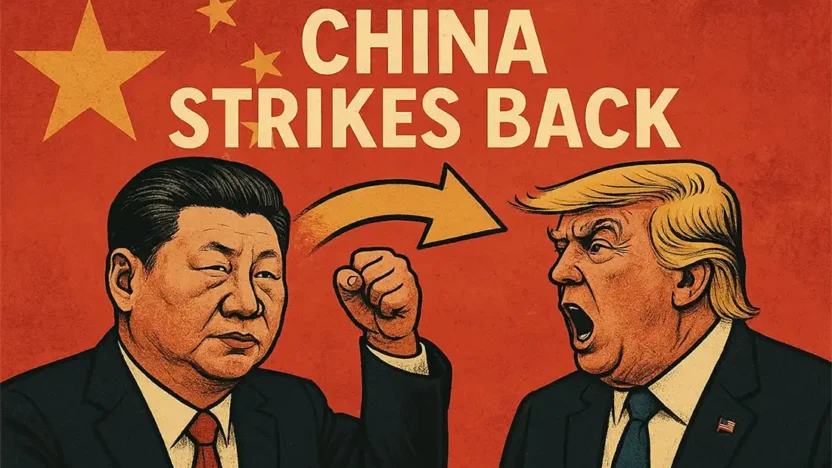The trade war has expanded beyond the U.S.–China standoff, drawing in the EU, Canada, and others. Markets are rattled, with stocks, oil, and currencies all under pressure. Beijing has responded with sweeping tariffs and blacklists. Washington, for now, remains defiant. The economic and geopolitical fallout is growing, and there’s no clear end in sight.
Trump’s Tariff Blitz Hits China Hard
Trump’s latest wave of tariffs took effect on 9 April, targeting dozens of countries but hitting China hardest. The headline figure was a 104% duty on all Chinese imports, following a 54% rate announced just last week. That earlier move now reads more like a prelude than a warning.
The escalation came in response to China’s retaliatory measures, continuing a now-familiar cycle of economic brinkmanship. Trump has pitched the tariffs as a solution to the persistent trade imbalance between the two countries. In 2024, the United States exported $143.5 billion to China and imported $438.9 billion. Economists remain sceptical that broad tariffs will do much beyond raising costs and straining supply chains.
Markets reacted quickly. Trump, however, was undeterred. He described it as a “great time” for companies to shift production to the United States, promising “zero tariffs” and fast-track approvals. The post, published on Truth Social, reinforced his usual position: prioritise American industry and let the fallout take care of itself.
U.S. Treasury Secretary Scott Bessent echoed the sentiment, calling China the “worst offender” in global trade and brushing aside concerns about Beijing’s response. Whether that confidence holds if the economic impact deepens is another matter.
China Retaliates with Tariffs and Blacklists
Beijing didn’t wait long. On 10 April, China raised tariffs on U.S. goods to 84%, more than doubling the previous 34% rate. The finance ministry described the move by Washington as a “mistake on top of a mistake,” accusing the U.S. of breaching trade rules and undermining China’s economic interests.
The retaliation didn’t stop at tariffs. China also imposed export controls on 18 U.S. firms, many linked to defence and advanced technology. A further six companies, including several in the artificial intelligence sector, were added to its “unreliable entity list,” effectively barring them from trade or investment activity in China.
A formal complaint is now en route to the World Trade Organization. Meanwhile, Beijing continues to frame its stance as defensive but proportionate. A newly published white paper argues that trade between the two countries is broadly balanced once services are counted, pointing to a $26.57 billion U.S. surplus in 2023.
As for what happens next, the message from Chinese officials is blunt. Talks remain on the table, but only if the U.S. approaches them with “equality and respect.” Otherwise, they say they’re prepared to “fight to the end.” That might be diplomatic posturing, but it’s not a bluff anyone is eager to test.
EU and Allies Join Trade War
The trade dispute has officially outgrown its original billing as a U.S.–China affair. The European Union is now firmly in the mix, approving retaliatory tariffs on €20.9 billion worth of American goods. The rollout is staggered: €3.9 billion on 15 April, another €13.5 billion in mid-May, and the final €3.5 billion by December, as reported by Euronews on 9 April 2025.
The move comes in response to Washington’s 25% tariffs on steel and aluminium, first introduced in March. EU officials have labelled the U.S. measures “unjustified and damaging,” but say they’re prepared to shelve their response if Washington returns to the table with a fair offer.
Diplomatic lines are starting to harden, and the geopolitical stakes are rising. Spain’s economy minister hinted that Beijing could become a strategic partner, a remark that didn’t go unnoticed in Washington. Treasury Secretary Scott Bessent issued a blunt warning to European allies, likening any pivot towards China to “cutting your own throat.”
Canada is also pushing back, while Japan appears more open to negotiation, signalling that not all U.S. partners are taking the same route.
Markets Slide as Trade Tensions Escalate

Global markets reeled on Wednesday as the trade war shifted from political spectacle to economic reality. U.S. stock futures and European shares slid sharply following China’s tariff hike, triggering a widespread sell-off across risk assets.
Oil prices dropped to a four-year low. U.S. government bonds sold off. The yuan hit record lows, and China’s central bank stepped in to contain the slide. Volatility surged as investors weighed the growing threat to global growth.
Trillions in market value have already been erased this week. Recession risk is back in focus, alongside concerns about inflation and eroding corporate margins. Pharmaceutical stocks fell after Trump floated the idea of tariffs on drug imports, rattling an already anxious sector.
Nomura’s chief China economist, Ting Lu, described it as an “expensive game of chicken,” with both sides showing little sign of blinking. Beijing is bracing for pressure on its export engine, even as domestic stimulus efforts try to soften the blow. Trump, for his part, claims countries are “dying” to make deals. Whether that reflects market sentiment is another matter entirely.
Global Trade War: What Comes Next?
The global trading landscape is shifting rapidly. Tariffs keep climbing, alliances are under strain, and markets remain jittery. While Washington and Beijing continue to exchange economic blows, other countries are being drawn in, some reluctantly, others with strategic intent.
There’s still no resolution in sight. What began as a bilateral dispute has widened into a multi-front standoff, with economic strategy often sidelined by political theatre. For investors and policymakers alike, this is now a world shaped more by confrontation than by coordination.


